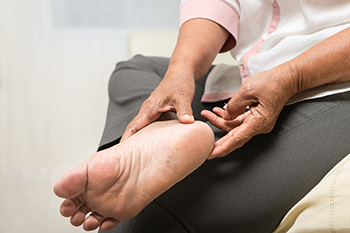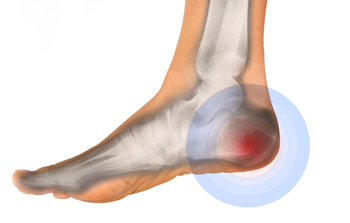
The foot condition known as plantar fasciitis occurs when the plantar fascia becomes inflamed. This is the band of tissue that is found on the sole of the foot and connects the heel to the toes. It also creates the arch in the foot. One of the first symptoms of plantar fasciitis is heel pain and it may be worse upon arising in the morning. It can develop as a result of repetitive stress that is common among runners, or it may happen from overstretching. People who have flat feet or high arches may be prone to developing this condition, in addition to being obese or pregnant. It may also happen from wearing shoes that do not fit correctly. The symptoms that many people have can consist of severe pain, swelling, and redness in the heel area, and it may be difficult to walk. If the condition is mild, relief may be found when specific stretches are performed. Additionally, custom-made orthotics may be worn so daily activities can be completed with little or no pain. For severe cases, surgery may be necessary for permanent relief. If you have heel pain, it is advised that you seek counsel from a podiatrist who can properly diagnose plantar fasciitis and offer you the correct treatment options.
Plantar fasciitis can be very painful and inconvenient. If you are experiencing heel pain or symptoms of plantar fasciitis, contact one of our podiatrists from Footcare Now. Our doctors can provide the care you need to keep you pain-free and on your feet.
What Is Plantar Fasciitis?
Plantar fasciitis is the inflammation of the thick band of tissue that runs along the bottom of your foot, known as the plantar fascia, and causes mild to severe heel pain.
What Causes Plantar Fasciitis?
- Excessive running
- Non-supportive shoes
- Overpronation
- Repeated stretching and tearing of the plantar fascia
How Can It Be Treated?
- Conservative measures – anti-inflammatories, ice packs, stretching exercises, physical therapy, orthotic devices
- Shockwave therapy – sound waves are sent to the affected area to facilitate healing and are usually used for chronic cases of plantar fasciitis
- Surgery – usually only used as a last resort when all else fails. The plantar fascia can be surgically detached from the heel
While very treatable, plantar fasciitis is definitely not something that should be ignored. Especially in severe cases, speaking to your doctor right away is highly recommended to avoid complications and severe heel pain. Your podiatrist can work with you to provide the appropriate treatment options tailored to your condition.
If you have any questions please feel free to contact our offices located in Elmhurst Jackson Heights, Astoria, NY, and Rego Park, NY . We offer the newest diagnostic and treatment technologies for all your foot and ankle needs.





